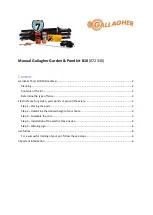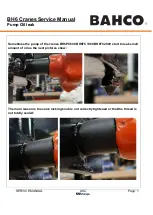
14
3.0 Installation
3.1 PLANNING:
Plan your fall protection system before starting your work. Account for all factors that may affect your safety
before, during, and after a fall. Consider all requirements and limitations defined in this manual.
3.2 ANCHORAGE:
Figure 9 illustrates typical SRD anchorage connections. The anchorage (A) should be directly overhead to
minimize Free Fall and Swing Fall hazards (see Section 1.4). Select a rigid anchorage point capable of sustaining the static
loads defined in Section 1.4. The Swivel Eye on the SRD is equipped with a Carabiner (B). Attach the Carabiner directly to
the anchorage structure (rebar, angle iron, etc.), a Tie-Off Adaptor (C), or Anchorage Connection Point (D).
3.3
HARNESS CONNECTION:
A Full Body Harness is required for Fall Arrest applications. Connect the Snap Hook (A) on
the SRD Lifeline to the Back Dorsal D-Ring (B) on the Full Body Harness (see Figure 10). For situations such as ladder
climbing, it may be useful to connect to the front Sternal D-Ring. Consult the harness manufacturer’s instructions for
details regarding use of the harness connection points.
4.0 USE
4.1
BEFORE EACH USE:
Before each use of this fall protection equipment carefully inspect it to assure it is in good working
condition. Check for worn or damaged parts. Ensure all bolts are present and secure. Check that the lifeline is retracting
properly by pulling out the line and allowing it to slowly retract. If there is any hesitation in retraction the unit should be
marked as “UNUSABLE” and returned to an authorized service center for service. Inspect the lifeline for cuts, frays, burns,
crushing and corrosion. Check locking action by pulling sharply on the line. See Section 5 for inspection details. Do not use if
inspection reveals an unsafe condition.
;
First time or infrequent users of 3M Self-Retracting Devices (SRDs) should review the “Safety Information” at the
beginning of this manual prior to use of the SRD.
;
If the risk assessment carried out before the start of the work shows that the edge is very cutting and, or, free
of burrs; relevant measures should be taken before the start of the work to prevent a drop over the edge, an edge
protection should be mounted, or the manufacturer should be contacted.
4.2
AFTER A FALL:
Any equipment which has been subjected to the forces of arresting a fall or exhibits damage consistent
with the effect of fall arrest forces as described in Section 5, must be removed from service immediately, marked as
“UNUSABLE”, and inspected and serviced as instructed in Sections 5 and 6.
;
Ensure there is direct or indirect visual contact or some other means of communication with the person being rescued
at all times during the rescue process.
4.3
BODY SUPPORT:
A full body harness must be worn when using 3M SRDs. For general fall protection use, connect to
the back Dorsal D-Ring. For situations such as ladder climbing, it may be useful to connect to the front Sternal D-Ring.
Consult the harness manufacturer’s instructions for details regarding use of the harness connection points.
4.4
MAKING CONNECTIONS:
When using a hook to make a connection, ensure roll-out cannot occur (see Figure 5). Do not
use hooks or connectors that will not completely close over the attachment object. Do not use non-locking snap hooks.
The mounting surface should meet the anchorage strength requirements stated in section 2.2. Follow the manufacturer’s
instructions supplied with each system component.
4.5 OPERATION:
Inspect the SRD as described in section 5.0. Connect the SRD to a suitable anchorage or anchorage
connector as previously described. Connect the Self-Locking Snap Hook on the end of the lifeline to the Dorsal D-Ring on
the Full Body Harness (see Figure 10). Ensure connections are compatible in size, shape, and strength. Ensure hook is
fully closed and locked. Once attached, the worker is free to move about within the recommended working area at normal
speeds. If the RSQ Selection Knob is set to
‘Fall Arrest’
, the SRD will arrest the fall. If the RSQ Selection Knob is set to
‘Descent’
, the SRD will automatically descend the user to a lower level when a fall occurs. When working with an SRD,
always allow the lifeline to recoil back into the device under control. A tag line may be required to extend or retract the
lifeline during connection and disconnection operations. A tag line can be used to prevent uncontrolled retraction of the
lifeline into the SRD. Depending on the work site environment and conditions, it may be necessary to restrain the free end
of the tag line to prevent interference and entanglement with equipment or machinery.
4.6
RSQ™ FALL ARREST/DESCENT MODE SELECTION:
3M RSQ™ Dual-Mode SRDs are equipped with an RSQ Knob to select between the Fall Arrest or Descent operating
modes of the SRD (see Figure 11). To select Fall Arrest Mode or Descent Mode:
1.
Pull the RSQ™ Engagement Knob outward.
2.
Turn the RSQ™ Engagement Knob until the arrow on the face of the knob points to Descent Mode (A) or Fall Arrest
Mode (B) and the RSQ™ Engagement Knob clicks into place with the Selection Notch (as illustrated in Figure 11).
RSQ Descent Mode:
In Descent Mode, the user automatically descends to a lower level when a fall occurs.
RSQ Fall Arrest Mode:
In Fall Arrest Mode, the SRD arrests the fall and the user remains suspended. Descent is
activated and controlled with the RSQ™ Engagement Knob Pull Ring or an optional Extension Pole Release Tool (see Figure
12):
• Engagement Knob Pull Ring:
Figure 12 illustrates operation of the Engagement Knob Pull Ring. To disengage Fall
Arrest Mode and initiate descent, grasp the Pull Ring and pull the Engagement Knob straight out (A). To stop descent;
release the Pull Ring to re-engage Fall Arrest Mode (B). To fully engage Descent Mode so descent continues without
pulling the Pull Ring, turn the Engagement Knob counter-clockwise (C) until the arrow on face of the knob points to
Summary of Contents for ULTRA-LOK Series
Page 2: ...2 2 A C B A E D B F C H 3 A B FC FF DD SF FC FF DD SF C FC 4C...
Page 5: ...5 9 10 B A A C B A D B A B 11 A B...
Page 6: ...6 12 A B C D 13 14 15 16 B A C A D C B A...
Page 146: ......
Page 147: ......















































